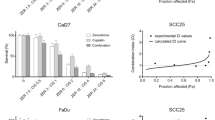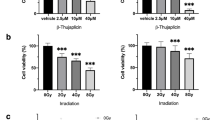Abstract
Background and Purpose:
Betulinic acid, a pentacyclic triterpene, is a new cytotoxic compound active on melanoma, neuroblastoma, glioblastoma and head and neck squamous cell carcinoma (HNSCC) cells. In combination with irradiation it has been shown to have an additive effect on growth inhibition in melanoma cells. In this study, the radiosensitizing effect of betulinic acid on sequential irradiation was investigated in HNSCC cell lines.
Material and Methods:
Two HNSCC cell lines, SCC9 and SCC25, were treated with increasing doses of betulinic acid and sequentially irradiated with a single boost of 4 Gy from a conventional radiation source. The cells were counted, the surviving fraction was determined, and colony-forming assays were performed.
Results:
It could be shown that betulinic acid alone inhibits cell survival, affects cell survival additively in combination with irradiation and decreases clonogenic survival in both cell lines when applied alone.
Conclusion:
Betulinic acid could be a promising treatment agent in radioresistant head and neck cancer. A combination of betulinic acid with radiotherapy seems to be beneficial.
Zusammenfassung
Hintergrund und Ziel:
Betulinsäure, ein pentazyklisches Triterpenoid, ist ein neuer zytotoxischer Wirkstoff mit Wirkung gegen Melanom-, Neuroblastom-, Glioblastom- sowie Kopf- und Halstumorzellen. In Kombination mit Radiotherapie zeigte sich ein additiver Effekt auf die Wachstumshemmung in Melanomzellen. In dieser Studie wurde untersucht, ob Betulinsäure ein Radiosensitizer bei sequentieller Bestrahlung von Kopf- und Halstumorzellen ist.
Material und Methodik:
Die beiden Kopf- und Halstumorzelllinien SCC9 und SCC25 wurden mit ansteigenden Dosen von Betulinsäure und sequentieller Radiotherapie mit einer Einzeldosis von 4 Gy (Abbildungen 1a und 1b) an einem konventionellen Bestrahlungsgerät behandelt. Dann wurden die Zellen gezählt, das Überleben bestimmt (Abbildungen 2a und 2b) und Koloniebildungsassays durchgeführt (Abbildungen 3a und 3b). Die immunhistochemische Untersuchung erfolgte mit dem M30-Antikörper zur Visualisierung der Apoptose (Abbildungen 4a und 4b).
Ergebnisse:
Es konnte gezeigt werden, dass Betulinsäure allein das Zellüberleben inhibiert, additiv in Kombination mit Radiotherapie agiert und in beiden Zelllinien die Koloniebildungsfähigkeit herabsetzt.
Schlussfolgerung:
Betulinsäure könnte ein vielversprechendes Chemotherapeutikum bei radiotherapieresistenten Kopf- und Halstumoren sein. Eine Kombination von Betulinsäure und Strahlentherapie scheint vorteilhaft.
Similar content being viewed by others
References
Aapro MS, Alberts DS, Salmon SE. Interactions of human leukocyte interferon with vinca alkaloids and other chemotherapeutic agents against human tumors in clonogenic assay. Cancer Chemother Pharmacol 1983;10:161–6.
Belka C, Jendrossek V, Pruschy M, et al. Apoptosis-modulating agents in combination with radiotherapy - current status and outlook. Int J Radiat Oncol Biol Phys 2004;58:542–54.
Czembirek C, Eder-Czembirek C, Erovic BM, et al. The cyclooxygenase-2 inhibitor nimesulide, a nonsteroidal analgesic, decreases the effect of radiation therapy in head-and-neck cancer cells. Strahlenther Onkol 2009;185:310–7.
Enari M, Sakahira H, Yokoyama H, et al. A caspase-activated DNAase that degrades DNA during apoptosis, and its inhibitor ICAD. Nature 1998;391:43–50.
Fulda S, Friesen C, Los M, et al. Betulinic acid triggers CD95 (APO-1/Fas)- and p53-independent apoptosis via activation of caspases in neuroectodermal tumors. Cancer Res 1997;57:4956–64.
Fulda S, Jeremias I, Steiner HH, et al. Betulinic acid: a new cytotoxic agent against malignant brain-tumor cells. Int J Cancer 1999;82:435–41.
Fulda S, Scaffidi C, Susin SA, et al. Activation of mitochondria and release of mitochondrial apoptogenic factors by betulinic acid. J Biol Chem 1998;273:33942–8.
Fulda S, Susin SA, Kroemer G, Debatin KM. Molecular ordering of apoptosis induced by anticancer drugs in neuroblastoma cells. Cancer Res 1998;58:4453–60.
Gabryś D, Dörfler A, Yaromina A, et al. Effects of lovastatin alone or combined with irradiation on tumor cells in vitro and in vivo. Strahlenther Onkol 2008;184:48–53.
Garg AK, Buchholz TA, Aggarwal BB. Chemosensitization and radiosensitization of tumors by plant polyphenols. Antioxid Redox Signal 2005;7:1630–47.
Leers MP, Kölgen W, Björklund V, et al. Immunocytochemical detection and mapping of a cytokeratin 18 neo-epitope exposed during early apoptosis. J Pathol 1999;187:567–72.
MacFarlane M, Merrison W, Dinsdale D, Cohen GM. Active caspases and cleaved cytokeratins are sequestered into cytoplasmic inclusions in TRAIL-induced apoptosis. J Cell Biol 2000;148:1239–54.
Miles DH, Kokpol U, Zalkow LH, et al. Tumor inhibitors I: preliminary investigation of antitumor activity of Sarracenia flava. J Pharm Sci 1974;63:613–5.
Oya N, Zölzer F, Werner F, Streffer C. Similar extent of apoptosis induction at doses of X-rays and neutrons isoeffective for cell inactivation. Strahlenther Onkol 2008;184:270–5.
Pisha E, Chai H, Lee IS, et al. Discovery of betulinic acid as a selective inhibitor of human melanoma that functions by induction of apoptosis. Nat Med 1995;1:1046–51.
Sandberg F, Dutschewska H, Christov V, Spassov S. Spondiathus preussii var. glaber Engler. Pharmaceutic screening of triterpenes. Acta Pharm Suec 1987;24:253–6.
Schmidt ML, Kuzmanoff KL, Ling-Indeck L, Pezzuto JM. Betulinic acid induces apoptosis in human neuroblastoma cell lines. Eur J Cancer 1997;3:2007–10.
Schütze C, Dörfler A, Eicheler W, et al. Combination of EGFR/HER2 tyrosine kinase inhibition by BIBW 2992 and BIBW 2669 with irradiation in FaDu human squamous cell carcinoma. Strahlenther Onkol 2007;183:256–64.
Selzer E, Pimentel E, Wacheck V, et al. Effects of betulinic acid alone and in combination with irradiation in human melanoma cells. J Invest Dermatol 2000;114:935–40.
Sheth K, Jolad S, Wiedhopf R, Cole JR. Tumor-inhibitory agents from Hyptis emoryi (labiatae). J Pharm Sci 1972;61:18–9.
Thurnher D, Turhani D, Pelzmann M, et al. Betulinic acid: a new cytotoxic compound against malignant head and neck cancer cells. Head Neck 2003;25:732–40.
Veldwijk MR, Herskind C, Sellner L, et al. Normal-tissue radioprotection by overexpression of the copper-zinc and manganese superoxide dismutase genes. Strahlenther Onkol 2009;185:517–23.
Vokes EE, Weichselbaum RR, Lippman SM, Hong WK. Head and neck cancer. N Engl J Med 1993;328:184–94.
Zuco V, Supino R, Righetti SC, et al. Selective cytotoxicity of betulinic acid on tumor cell lines, but not on normal cells. Cancer Lett 2002;175:17–25.
Author information
Authors and Affiliations
Corresponding author
Rights and permissions
About this article
Cite this article
Eder-Czembirek, C., Erovic, B.M., Czembirek, C. et al. Betulinic Acid a Radiosensitizer in Head and Neck Squamous Cell Carcinoma Cell Lines. Strahlenther Onkol 186, 143–148 (2010). https://doi.org/10.1007/s00066-010-2069-6
Received:
Accepted:
Published:
Issue Date:
DOI: https://doi.org/10.1007/s00066-010-2069-6




